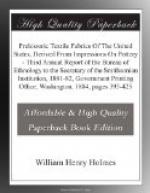[Footnote 2: Keller: Lake-Dwellers. Fig. 2, Pl. CXXXIV.]
An illustration of this form of fabric is given by Foster,[3] and reproduced in Fig. 69.
[Illustration: Fig. 69.—Cloth from a mound, Ohio.]
[Footnote 3: Foster: Prehistoric Times.]
In the same place this author presents another form of cloth shown in my Fig. 70. In Fig. 71 we have a section of this fabric. These cloths, with a number of other specimens, were taken from a mound on the west side of the Great Miama River, Butler County, Ohio. The fabric in both samples appears to be composed of some material allied to hemp. As his remarks on these specimens, as well as on the general subject, are quite interesting, I quote them somewhat at length.
“The separation between the fibre and the wood appears to have been as thorough and effectual as at this day by the process of rotting and hackling. The thread, though coarse, is uniform in size, and regularly spun. Two modes of weaving are recognized: In one, by the alternate intersection of the warp and woof, and in the other, the weft is wound once around the warp, a process which could not be accomplished except by hand. In the illustration the interstices have been enlarged to show the method of weaving, but in the original the texture was about the same as that in coarse sail-cloth. In some of the Butler County specimens there is evidently a fringed border.”
[Illustration: Fig. 70.—Cloth from a mound, Ohio.]
[Illustration: Fig. 71.—Section.]
In regard to the second specimen described, I would remark that it is a very unusual form, no such combination of the parts having come to my notice either in the ancient fabrics themselves or in the impressions on pottery. In a very closely woven cloth it might be possible to employ such a combination, each thread of the web being turned once around each thread of the woof as shown in Fig. 71; but certainly it would work in a very unsatisfactory manner in open fabrics. I would suggest that this example may possibly belong to my second group, which, upon the surface, would have a similar appearance. The combination of this form is shown in the section, Fig. 73.
Second group.
It is not impossible, as previously stated, that open fabrics of the plain type were avoided for the reason that the threads would not remain in place if subjected to tension. A very ingenious method of fixing the threads of open work, without resorting to the device of knotting has been extensively employed in the manufacture of ancient textiles. The simplest form of cloth in which this combination is used is shown in Fig. 72. This example, which was obtained from a small fragment of pottery found in Polk County, Tennessee, may be taken as a type.
[Illustration: Fig. 72.—From ancient pottery, Tennessee.]
[Illustration: Fig. 73.—Section.]




